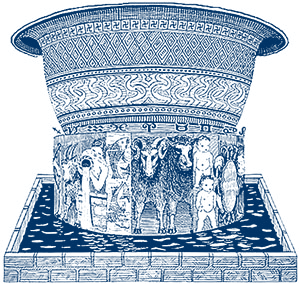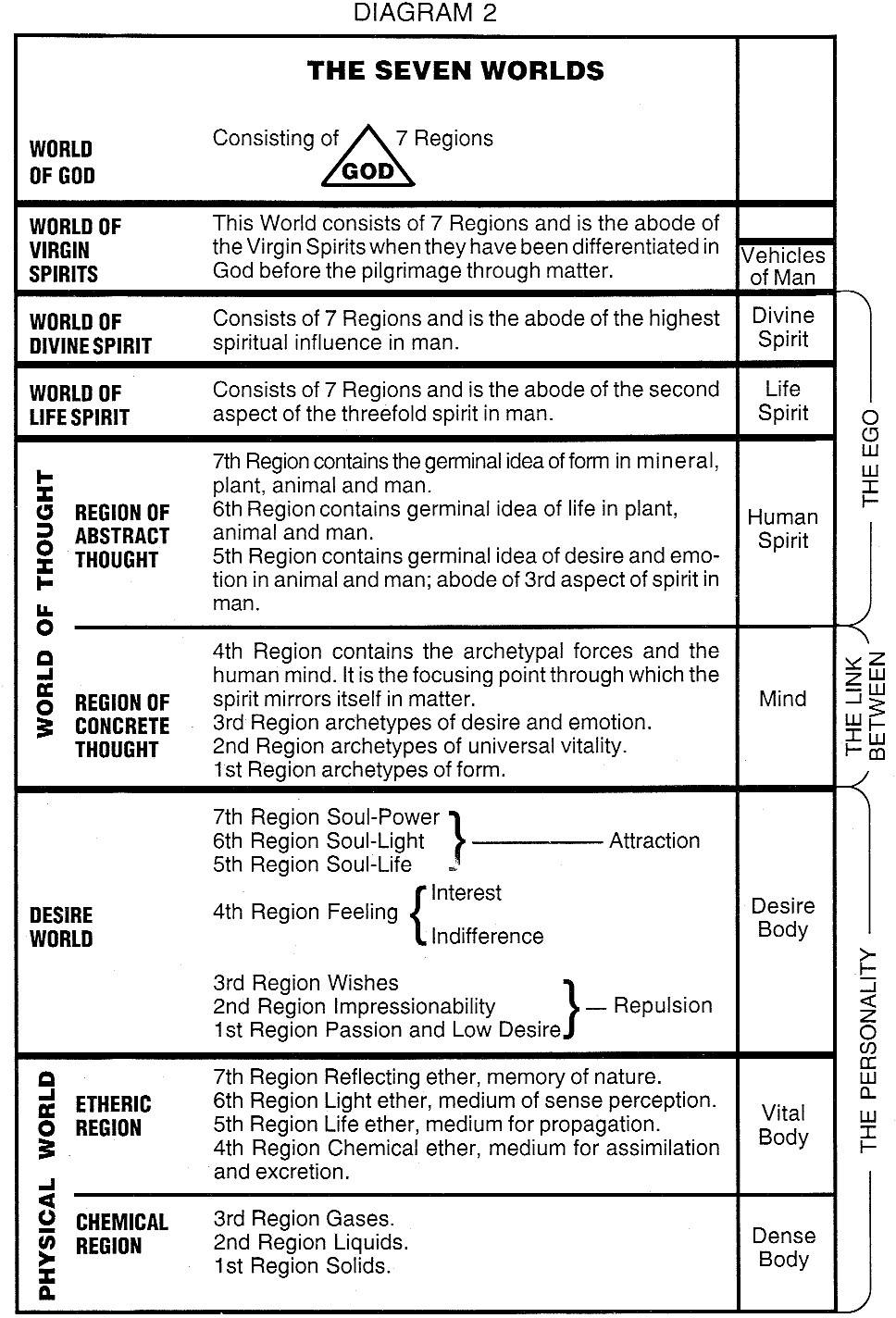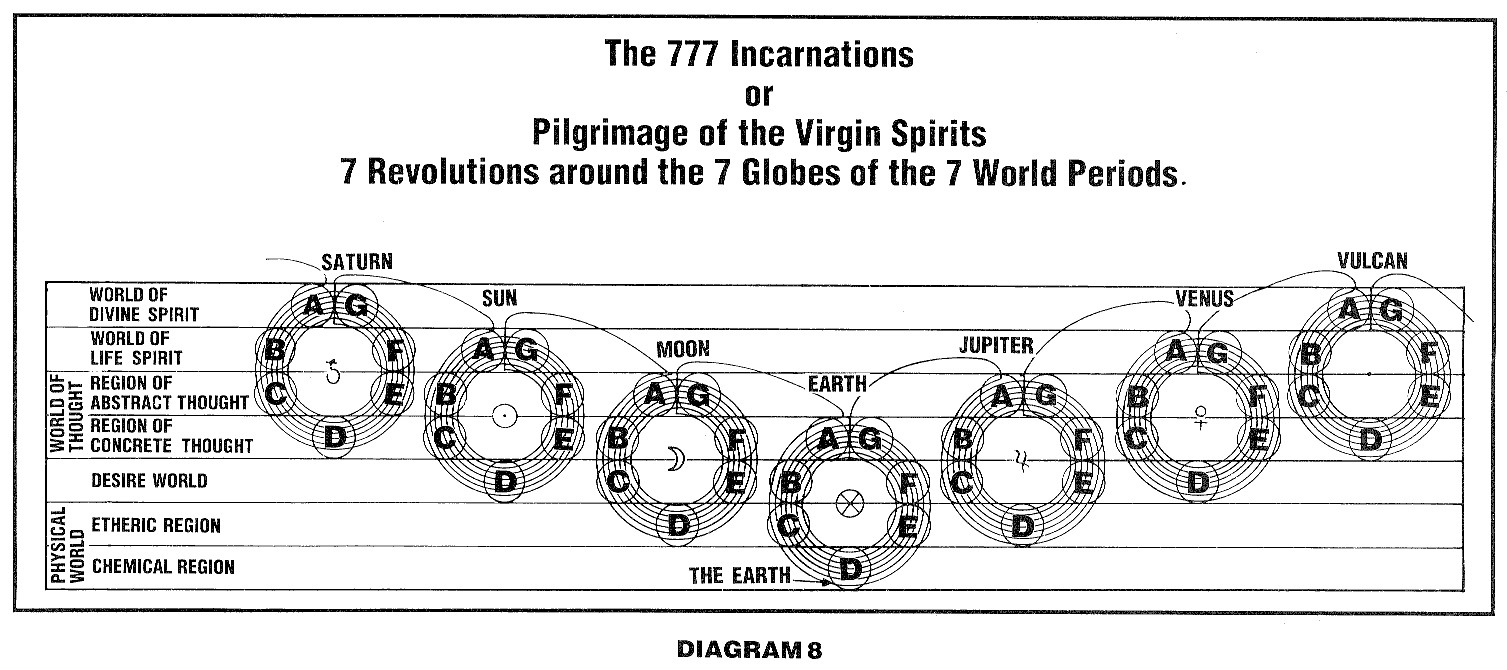
| rosicrucianU.com | ||
| Simplified Scientific Christianity |

|
"As each musical instrument has its own particular tonal range and tonal quality, so does each planet have its essential quality as a focalizer of one of the twelve zodiacal signs. The 'octaves' of a planet are the levels of consciousness that the person has toward the specific life-principle on succeeding evolutionary cycles, just as there are seven 'C's' on the piano-keyboard." |
The composition of music is the manifestation of archetypes by formalized, rhythmic arrangement of tone. It is the representation of that which is perceived by inner hearing, it is the language by which the intuition of the artist communicates itself to the intuitions of humanity. By correspondence, we might say that prose is to poetry what poetry is to music — three "octaves" of communicative art. Music is "language transcendentalized;" if words are sound-symbols of identities, tones are the archetypes of sounds, and their artistic manifestation in pattern and structure by composite of melody, harmony, rhythm, and tempo is a "speech that transcends, in power, the language of words. Word-language is a relatively limited communication; its comprehension depends on a specialized exercise of the intellect. Tone-language, essentially archetypal, depends on exercise of intuition and emotion-responsiveness; its appeal is to the instinctual urge of humans to realize ideality. The magic — and it is one of the greatest of all magics of melody and harmony transcends the separativeness of nationalistic consciousness, from which is derived the separate variety of word-language. To respond to music is to hear ideality, and the specialized faculties of the manifestive and interpretative musicians of the world are "channelings" by which messages of great beauty and truth are communicated to the soul-consciousness of humanity.
The planetary triad of "communication" is that of Moon, Mercury, and Neptune. These three planets represent the three octaves of mentation: the subconscious mind of instinct and feeling, the conscious mind of intellect, and the super-conscious mind of archetype-perception, respectively. All humans, however primitive, partake of the first two of these octaves because all are capable of organizing opinion (the Moon) by subconscious feeling and all who can talk have the faculty of intellect-exercise (Mercury). Only those who are capable of perceiving and expressing archetypes are those who function consciously and constructively on the third octave of Neptune as "focalizer" of the vibration of Pisces, the mutable sign of the water-trine initiated by the Moon through Cancer, polarity of Mercury's Virgo, and tenth-house sign of Mercury's Gemini. In its regenerate, spiritualized qualities, it symbolizes the most transcendental faculties of human consciousness — that of communicativeness with the Higher Self and the aware-ness of the existence of the archetype. Let us study the astrological symbol for Neptune:
Exoterically, this symbol pictures the trident of the ocean-god; as such, it carries out the literal, personalized representation by which life-principles were taught to the uninitiated, literal-minded people of ancient times. Esoterically, it is not a trident at all; the up-turned semi-circle is "chalice" or the upraised arms of the horizontal diameter of the cardinal cross of the Great Mandala — the "male-female begotten" of humanity. The vertical line is the same as is that of the Great Mandala — the generative line of parentage, human or divine. The little circle at the bottom of the symbol is the "seed" of the soul body of humanity which is "stimulated into new life" by divine powers. This little circle is analogous to the "Cancer-point" of the Great Mandala and in this symbol it is the "seed" of all perfected realizations, the matrix of the "Golden Wedding Garment." This symbol is truly one of the most beautiful in astrology. It is symmetrical, and its verticality is counterbalanced by the loveliness of the open, up-reaching arms of the semi-circle like a tree with its branches lifted or a human with his arms lifted in an ecstasy of reverence or aspiration or joy. Now to correspond this symbol with that of Venus whose exaltation is in Pisces:
The cross at the bottom of Venus's symbol is closed (rounded out) into the perfect circle of "soul-consciousness;" the circle of Venus's symbol is opened into the chalice which receives the divine. In this "opening of Venus" we see the secret of Neptune's transcendental nature: the beauty of perfect manifestation that Venus symbolizes is actually the formalization of the essential beauty of Neptune. If Venus is the beauty of symmetry, design, and rhythm in art, Neptune is the beauty of cosmic symmetry, design, and rhythm; if Venus is the beauty of perfect manifestation, Neptune is the beauty of archetype; if Venus is the altar or shrine, Neptune is the god to whom the shrine is dedicated; if Venus is the exoteric myth which is created to convey a spiritual allegory, Neptune is the life-principle personified by the myth; if Venus is the melody which moves the heart, Neptune is the archetypal memory-of-experience which is stimulated by the melody; if Venus is the beautiful gesture or movement of the dancer, Neptune is the essence of the emotional or spiritual realization expressed by the gesture; if Venus is the harmonious progression of colors which is the "life" of the painting, Neptune is the inner vision of the painter; if Venus is the composite beauty of melody, harmony, rhythm, and text of a perfectly wrought song, Neptune is that which is transmitted as spiritual stimulus through the composer, thence through the singer, to the audience.
The femininity of Neptune is portrayed by the up-turned semi-circle. A horizontal line is abstractly feminine as the essence of "that which is affected by a cause" but this semi-circle focuses a much more intense feeling of "receptivity." To geometrize: if we enclose the structure of the Neptune-symbol in a circle of which the center-point is the jointure of the semi-circle and the vertical, and if we use the entire vertical of the circle as the vertical of the Neptune-symbol, it is interesting, and illuminating, to note that the two arms of the semi-circle cut the outer circle at the points corresponding to Scorpio and Pisces of the astrological mandala. These two signs plus the "Cancer-point" of the little circle at the bottom of the Neptune-symbol comprise the triad of the water- signs — the feminine — female principle of the zodiac and the triune faculty of sympathetic responsiveness of which the Pisces vibration represents the most impressionable and hypersensitive octave. So we have the aspiration of man- woman opening to the down-pouring of inspirational powers to ignite the "seed" of the soul-consciousness. This, in short, is the picture of inspiration in action; it is the picture of that subtle factor in human nature by which the human instrument becomes a vehicle of the divine (consciously) through spiritualized processes. Neptune, then, is the principle of instrumentation and its power is to make instruments of all artists by whom archetypal communications may be effected.*
All manifestive (creative) artists are priests in so far as they are all "mediators" between the divine and the mortal in mankind. And in no other art does the interpreter more deeply fulfill the role of acolyte than does the singer or the instrumental musician. The fusion of musical value with word-value that is inherent in the art of song is the composite of the abstraction of music with the concreteness of language. The words of poetic sentences and the notes of musical phrases are blended into a strange magical alchemy by which the poetic word is intensified and the musical idea is "concreted." Since tone is the archetype of sound and words are sequences of composited art of song is then seen to be the archetype of the art of poetic reading. The great song-manifestor is one who perceives intuitionally the musical value inherent in the literary text and by the exercise of a fusion of esthetic perceptions, the singer amalgamates these factors into the completed presentation of blended literary and musical art. The instrumental soloist and orchestral conductor fulfill a similar "acolyte-hood" in the realms of more purely abstract music; the orchestra, under direction, is a composite of many "acolytes" who (each in his own way) contribute to the total musical perfection. What, you ask, has all this to do with astrology? Where and how is music to be found in a horoscope? Let us see.
A musical score (lines and spaces grouped in measures) could be written in a circular form, the notes all having vertical stems pointing to the center of the circle. The lowest note of the score would be analogous to the circumference of the astrological circle, the highest note would be analogous to a circle close to the center of the wheel. In the treble and base staves of the ordinary musical lines we have five lines to each staff plus the median line of "middle C" — eleven lines in all. Create a circle big enough to contain ten concentric circles and subdivide into twelve sections just as the astrological mandala is sectioned into the twelve houses. Here we have the "low G " of the bass staff corresponding to the astrological circumference as the "emanation" of the Ascendant — point — the physical attribute, the densest vibration. The "high F" of the treble staff is the innermost of the enclosed circles and it might be taken to correspond, symbolically, to the most spiritual vibration of human consciousness — analogous to the vibration of Pisces in the Great Mandala.
The upper half of this diagram — a semi-circle enclosing ten other semi-circles is a symbolic picture of rainbow — the natural color-spectrum which has red, the densest color-vibration, as the "outside" of the arc, and purple, the fastest vibration, on the inside — closest to (what would be) the "center of the circle of which the rainbow is a major arc." Here we have color-spectrum, tone-spectrum, and the astrological spectrum of consciousness of humanity, all in one drawing. Draw this picture and think about it as "gradation of color," "gradation of tone" and "gradation of consciousness."
Straightening out the Aries-radius into a vertical and unfolding the composite circle into a straight horizontal picture gives us the tonal spectrum on a specified section of the "great musical scale." (Change the clef-signs and substitute one zodiacal sign and you have the astrological Ascendant which "determines" the personality-type of an individual just as the key-signature and metric signature "determine" the "personality" of the musical composition. Further analogy: the two staves of music might be considered symbolic of all tones that are used in our musical tradition; they might also be considered, symbolically, as the entire tonal range of all audible vibration, just as each specified color of the rainbow has its myriads of gradations, blending imperceptibly into each other by sequence of light-refraction. Astrologically this picture shows the gradation of human evolution, individually or as an archetype, from the densest vibration of utmost primitivity (separative, physical consciousness) to the utmost of spiritualized consciousness in masterhood. The primitive state is red and its tone is the lowest on what-ever symbol you are using; the masterhood-state is purple in color and its tone is the highest on whatever tonal scale you use for symbolic illustration. If you know how to write simple notation, try a simple example of "astro — musicianship:" a circle enclosing four other concentric circles; subdivide into four quadrants (measures); at the point corresponding to the astrological Ascendant, indicate, outside the wheel, a treble cleff, a key signature and three-four rhythm.
Each of the three signs of each quadrant is, of course, one "count." Using only the treble staff for simplicity, write in the notes of a melody in three-four rhythm — for example, the first four measures of "Missouri Waltz;" each four measures represents a complete "tour" of the circle. Let us further pretend that the diagram is really spiralic. When you finish the first four measures, in imagination, you write the next four measures on (what would be) the next "rung" of the spiral, and so on through the entire song. Another illustration: subdivide the four quadrants into three, creating the twelve astrological houses, or twelve measures of music; intensify the cusps of the first, fifth, and ninth houses, creating three phases of four measures (Fire, Earth, Air, Water) each; indicate "four-four" rhythm. And soon. You can vary your patterns in many ways — the point is this: Astrological symbology, music symbology, and color spectrum are designed in essentially the same way. A circle big enough to enclose several staves could, theoretically, be used to compose a vocal solo with piano-accompaniment or an instrumental combination.
As each musical instrument has its own particular tonal range and tonal quality, so does each planet have its essential quality as a focalizer of one of the twelve zodiacal signs. The "octaves" of a planet are the levels of consciousness that the person has toward the specific life-principle on succeeding evolutionary cycles, just as there are seven "C's" on the piano-keyboard.
If, in imagination, we might say that every human being evolves through seven major development cycles, these would be analogous to the seven octaves starting on the lowest "C" of the piano-keyboard; the twelve half-steps of each octave would be analogous to the twelve zodiacal signs. The planetary ruler of each sign could be analogous to the major triad of each of the twelve keys — Venus and Mercury ruling two each.
You can experiment with this idea in many ways; by a little exercise of your imagination you can analogize several musical and astrological factors. For example: musical discord and square aspect; the modulation from discord to harmony and sextile aspect (modulation from discord to harmony is alchemy expressed in music); the major triad based on a specific tone and the grand Trine based on a specific sign; the root-note of a major triad and a planet in dignity overtones of two notes played together and orbs of two planets in aspect to each, other; the soloist of a musical performance and the planetary ruler of a chart; instrumental or other accompaniment to a soloist and all the other planets beside the ruler of the chart. There is a wealth of imaginative research in making up titles of musical compositions by study of planetary groupings by house-position and sign-position, particularly those of the chart-ruler, as "key-note" of the horoscope. Such analogies can he very fascinating. Your interest in both arts will be intensified and your perceptions of the values of both can be greatly revivified as the result of such practice.
Now, the astrologer as "musician:"
As the great singer or instrumentalist interprets through tonal media the inspired archetypal concepts of the musical manifestor, so does the astrologer, by the power of the word, present his interpretations of archetypes — life principles — when he talks to a client or to a group of astrological students. As the musician develops his physical vehicle by technical exercise, so does the astrologer develop his mental vehicle in the exactitude of calculations and study of astrological technicalities. The "composition" that the astrologer interprets is always the vibratory being (the Consciousness) of humanity. The client is the " composer" of a specified astrological arrangement and the astrologer is the "acolyte" who serves the latent priesthood of the client. The musical manifestor and interpreter exercise their knowledge of esthetic (tonal and rhythmic) media to objectify their concepts of archetypes; the astrologer exercises his knowledge of human-life media as they specialize cosmic principles. The astrologer reflects the essence of what is in the client 's horoscope just as the singer or instrumentalist reflects that which is perceived in the score of the manifestor.
Astrologers "compose" when they devise new symbols and new approaches to astrological interpretation. For the most part, however they — and the interpretative musicians — communicate that which has already been manifested, in horoscopes or in musical scores. As the work of the manifestive and interpretative musician ignites the intuitional hearing of humanity, so does that of the astrologer by speech. The "artistry" of astrological service depends on the clarity with which such ignition can be made. This, in essence, is the purpose of his "star-song" as is the purpose of the others in their "tone-song." Both touch, as perhaps no other two arts can do, the immediacy of the abiding spirit. Both are consecrated to the service of "touching the Spirit" by sound in the most beautiful, efficacious, and inspiring ways possible.
*The above is in full recognition of the fact that "the ray of Neptune carries what esotericists know as the Father Fire, the light and life of the Divine Spirit, which expresses itself as will." Like all other planets, Neptune has its "reflective" as well as its "expressive" octave. The feminine polarity of Neptune's quality is that of our capacity to respond to higher-octave stimuli through inspirational attunement. Neptune, in this respect, is the archetypal symbol of our mystic qualities. A great actor or musician projects (dynamically) by his acting or playing or composing. That represents his "dynamic" Neptune. The attunement to archetypes and response to inspirational impulses from the Higher is the feminine polarity of that functioning.

|

|

|
|
|
Contemporary Mystic Christianity |
|
|
This web page has been edited and/or excerpted from reference material, has been modified from its original version, and is in conformance with the web host's Members Terms & Conditions. This website is offered to the public by students of The Rosicrucian Teachings, and has no official affiliation with any organization. | Mobile Version | |
|